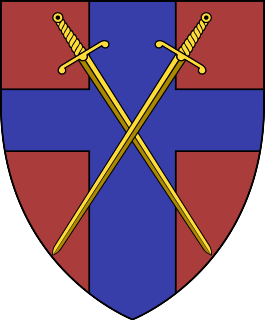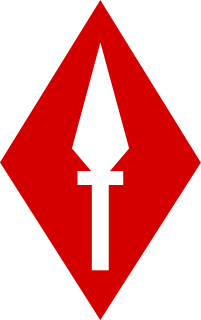
There have been two formations named British Army of the Rhine (BAOR). Both were originally occupation forces in Germany, one after the First World War, and the other after the Second World War. Both formations had areas of responsibility located around the German section of the River Rhine.

I Corps was an army corps in existence as an active formation in the British Army for most of the 80 years from its creation in the First World War until the end of the Cold War, longer than any other corps. It had a short-lived precursor during the Waterloo Campaign.

The 4th Infantry Division was a regular infantry division of the British Army with a very long history, seeing active service in the Peninsular War, the Crimean War, the First World War, and during the Second World War. It was disbanded after the war and reformed in the 1950s as an armoured formation before being disbanded and reformed again and finally disbanded on 1 January 2012.

The Royal Regiment of Fusiliers is an infantry regiment of the British Army, part of the Queen's Division. Currently, the regiment has two battalions: the 1st battalion, part of the Regular Army, is an armoured infantry battalion based in Tidworth, Wiltshire, and the 5th battalion, part of the Army Reserve, recruits in the traditional fusilier recruiting areas across England. The Royal Regiment of Fusiliers was largely unaffected by the infantry reforms that were announced in December 2004, but under the Army 2020 reduction in the size of the Army, its second battalion was merged into the first in 2014.
Options for Change was a restructuring of the British Armed Forces in summer 1990 after the end of the Cold War.
Tyneside Scottish is an honour title which has been held by a variety of British Army units since 1914. The Regiments which have held the title are the Northumberland Fusiliers, Durham Light Infantry, Black Watch and Royal Artillery. The Tyneside Scottish title is currently maintained by 204 Battery Royal Artillery.

The MGM-52 Lance is a mobile field artillery tactical surface-to-surface missile system used to provide both nuclear and conventional fire support to the United States Army. The missile's warhead was developed at Lawrence Livermore National Laboratory. It was replaced by MGM-140 ATACMS, which was initially intended to likewise have a nuclear capability during the Cold War.
The 1957 White Paper on Defence was a British white paper issued in March 1957 setting forth the perceived future of the British military. It had profound effects on all aspects of the defence industry but probably the most affected was the British aircraft industry. Duncan Sandys, the recently appointed Minister of Defence, produced the paper. The decisions were influenced by two major factors: the finances of the country and the coming of the missile age.

The 6th Infantry Brigade was a regular infantry brigade of the British Army that was in existence during the Second Boer War, the First World War and the Second World War and later formed part of British Army of the Rhine.
39 Regiment Royal Artillery was part of the Royal Artillery. Its name is pronounced "three nine", The Regiment was one of the Depth fire units of 1st Artillery Brigade, part of the British Army. It was formed in 1947, and placed into suspended animation on 20 February 2015. The Regiment was based at Albemarle Barracks in Northumberland.

The Northumberland Hussars was a Yeomanry regiment of the British Army, transferred to the Royal Artillery for the duration the Second World War. It was disbanded as an independent Territorial Army unit in 1967, a time when the strength of the Territorial Army was greatly reduced. The regiment's name lives on in the title of the command and support squadron of the Queen's Own Yeomanry (QOY), a Formation Reconnaissance Regiment based in Newcastle upon Tyne.

The Berlin Infantry Brigade was a British Army brigade-sized garrison based in West Berlin during the Cold War. After the end of World War II, under the conditions of the Yalta and Potsdam agreements, the Allied forces occupied West Berlin. This occupation lasted throughout the Cold War. The French Army also had units in Berlin, called Forces Françaises à Berlin and the US Army's unit in Berlin was the Berlin Brigade.
In September 1939, the British Army was in process of expanding their anti-aircraft and mobile assets. Among these new changes was the formation of Anti-Aircraft Command which was formed on 1 April 1939, and the 1st Armoured Division formed in 1937. The list below will include the British Army units, colonial units, and those units which were in the process of formation.

The 1st Artillery Brigade is an operational formation of the British Army which forms part of the 3rd Division, and oversees all close support artillery units of the army. Under the Future Soldier programme, the brigade will merge with 1st Armoured Infantry Brigade to form 1st Deep Recce Strike Brigade Combat Team.

The 59th (Warwickshire) Searchlight Regiment, Royal Artillery was an air defence unit of the Territorial Army (TA), part of the British Army, and was raised in Birmingham in 1938 just before the Second World War. It later served as a light anti-aircraft gun unit and continued in the postwar TA.
T Battery Royal Artillery is an air defence battery of the Royal Artillery that serves with the British Army's 12 Regiment Royal Artillery. It is stationed at Baker Barracks, Thorney Island, West Sussex.

140 Corps Engineer Regiment was a short-lived Territorial Army (TA) unit of the Royal Engineers based in the North Midlands of England during the 1960s.
The following is a hierarchical outline for the structure of the British Army in 1989. The most authoritative source for this type of information available is Ministry of Defence, Master Order of Battle, and United Kingdom Land Forces, HQ UKLF, UKLF ORBAT Review Action Plan, HQ UKLF, 1990.

The 2nd Northumberland Rifle Volunteer Corps, also referred to as the Tynemouth Rifles, was an infantry unit of Britain's part-time force, the Territorial Army. The corps was raised during the expansion of the Volunteer movement in the 1850s and then served with the Territorial Force during the First World War. It converted to an anti-aircraft role just prior to Second World War, and continued to serve until it was amalgamated in 1950.

The 3rd (Ulster) Searchlight Regiment was a Supplementary Reserve (SR) unit of the Royal Artillery raised in Northern Ireland just before the outbreak of World War II. It distinguished itself in the Battle of France before being evacuated from Dunkirk. It then served in Anti-Aircraft Command, converting into the 4th (Ulster) Light Anti-Aircraft Regiment in 1942. In that role it served in the campaign in North West Europe, defending Brussels against V-1 flying bombs. It was reformed postwar and its successor units continued to serve in the Territorial Army (TA) until 1993.










